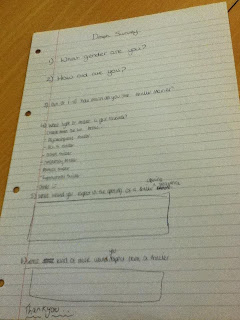How has the continuity task aided your understanding of the film making process?
The continuity task has really helped me to realise that the process of making a film is actually alot more difficult than it seems. The task has definitely been very good practice for when we actually start filming our opening title sequence. All of the problems that we faced making this will help us avoid the same ones when filming our thriller opening title sequence and help us improve on planning, filming and editing.What problems did we come across during the continuity task and how did we overcome them?
During the continuity task we came across quite a few small problems, that we managed to overcome. Firstly one of the locations we filmed in was unreliable as we had to make sure that room was empty when we needed to film- which we didn't check first. This became a problem as we decided we should re-shoot one of our shots but the room was occupied at the time. In the end we decided to shoot next time it was empty and had to wait until the next day which made timing complicated as we needed to finish shooting and complete the task. Another problem was when we were finishing shooting, we had edited everything and put it all together but weren't happy with the ending due to it not being continuous, however we will learn from this next time and make sure to look back at the shots and see if they have good continuity and if they don't, then re-shoot.
In our continuity task, I think our editing was very good and we learnt alot about using Adobe Premier Pro, which will help us immensely when it comes to editing our actual thriller opening title sequence. I also think that it was continuous apart from the last bit which let us down but that's something we will learn from. We had a variety of camera angles and also interaction between characters that we are proud of, and we also stuck to the 180 degree rule.
The storyboarding process and shot list
The storyboarding and shot list was harder than I expected. This is because we didn't realise how much we would actually rely on it until we began this continuity task. Our storyboard however wasn't as accurate as it could have been and this has helped us realise that we need to put more time into it when we making our opening title sequence. The shot list was very helpful and although we changed it around a bit, we still relyed on it alot. This has also helped us understand the importance of research and planning as it would look very unorganised without the planning and the it helped us all with our organisation aswell as we made sure we knew what we were doing at all times. Hannah and I filmed, whilst Finley and Jacob performed in our continuity task, however they both helped with the camera angles and the editing. Another reason research and planning is very important is because it saves a massive amount of time. We hadn't planned the music we were going to include, which meant alot of time trying to find the right piece that fit into our piece.
Overall, this continuity task has really improved all of the group's skills in all three areas; planning, filming and editing. When making the opening title sequence, we now have an idea of what it's going to be like and we know what problems we may face and how we can avoid them.

















































